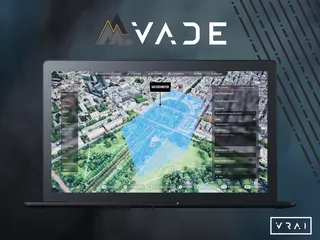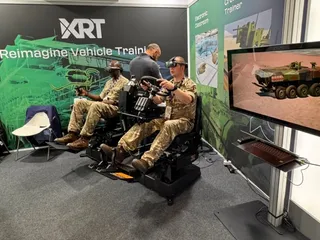A Soft Reboot for BISim in 2025
Contact Our Team
For more information about how Halldale can add value to your marketing and promotional campaigns or to discuss event exhibitor and sponsorship opportunities, contact our team to find out more
The Americas -
holly.foster@halldale.com
Rest of World -
jeremy@halldale.com
.jpeg/r%5Bwidth%5D=320/a0ad6ef0-b23b-11ef-b657-4f5234124260-MS%26T%203%20Dec%20IITSEC%20fireside%20chat%20MPK%2C%20Seb%20PM%20(1).webp)
The author had the pleasure of moderating yesterday’s fireside chat “Evolution of Simulation – Insights into BiSim’s Journey Ahead” at the Bohemia Interactive Simulations booth and amphitheater during I/ITSEC 2024. Pete Morrison, Chief Product Officer at the company and his colleague Seb Lozé, Vice President, Products Innovation, briefly discussed a wide range of issues during their 30-minute presentation.
An extract and highlights of themes and comments generated during the session included:
- Novelty, Change and Community Player. Morrison first recalled BISim was acquired by BAE Systems in 2022 and was given the mandate to grow the business. “There are several ways you can do this – you can build, buy or partner and we decided largely to partner.” That decision is evident at this conference when a mix of six of BISim’s industry partners in their broader ecosystem are exhibiting at the company’s booth: Haptech, Kongsberg, Pitch, Rheinmetall, SEI, and VRAI. BISim also began to open up its software about 10 years ago, with VBS 4 and its simulation SDK, enabling more companies to take the software, and quickly extend and deploy it in different and varied ways. “It’s been a long journey as we have opened up the platform more and more over the years,” Morrison reflected and added, “The partners here at the booth are obviously not our only partners, there are many, many more. We’re also reselling a broad range of software, more than we ever had before.” uCrowds, for example, is a crowd simulation software that is pushing VBS to the next level. Morrison emphasized, “We’re going to continue to increase our ecosystem, increase the number of partners that we have and we’re excited about that!”
- Impressions: six months after joining BISim. Lozé joined the BISim team this July. He has been actively engaging with product development team stakeholders and architects since this achieving his latest career milestone. Concurrently, Bohemia has also just announced 24.2 for VBS, BlueIG and Mantle. After transitioning to BISIm, Lozé recalled “I had a lot of new people to meet and discover a new crowd that I did not have a connection with before. The team of people are fascinated in, and passionate about, the development of solutions for the end user. It is part of their future and part of their DNA.” Another surprising attribute the new executive did not expect to find at BISim was the openness to standards and modularity, and a new way of doing things. Additional, pleasant discoveries at the new company included a much younger and more diverse workforce than can be found at other community companies, and his new colleagues’ “openness and appetite for evolution and innovation.”
- AI in the simulation domain: observations and megatrends.Morrison initially observed there is confusion and an urgency about the use of AI in defense. Adding to that sense of urgency was his observation that potential adversaries are heavily investing in AI for autonomous drones, assistance for commanders, and many other ways to use AI for military purposes. “Here at Bohemia, we are still focused on AI to support the commanders and soldiers that use our software – AI that, by and large, does what it is told, to meet specific training outcomes. We feel we have come a very long way with the AI technologies that we have. One of the reasons Seb came on board was to help us shape our roadmap – exploiting, for example, generative AI.” Lozé picked up the discussion declaring that technology does not stop at the walls of I/ITSEC, and that beyond the AI megatrend we are all observing, there are also many technologies coming from different domains that can be manipulated into turnkey, applicative solutions. “We see ourselves as a potential funnel of all these technologies, including AI, that are very hard to apprehend, and forming them into turnkey applications that can be directly used for training, or for modeling novel technologies or novel capacities for the end user.”
- Open Standards. Lozé initially declared, “I love SISO and have been a member of SISO for a long time, since I joined the simulation community. I think I was the youngest member at one point. But what scares me is I still think I am the youngest member. We need some new blood. We need more people to embrace that concept of standards.” The executive noted BISim’s industry partner, Pitch, is a strong proponent of community standards. Other community efforts to embrace standards can be observed in terrain generation with the Open Terrain Generator, the United States Geospatial Intelligence Foundation (USGIF) and the NATO Modeling and Simulation Group Research Task Group MSG-223. The executive added, “We’re a community player. We need to connect further with the rest of the industry!”
- Use Cases and Evolution. BISim’s portfolio is expanding beyond military training into first response, geospatial and other heretofore “verticals.” Morrison emphasized this is the story of his company’s future. “We have been known as the VBS 4 guys for a long time. And we’re so proud of that product. We are also focused on making that the best it can be and we’re also building a lot of interesting technology outside the military tactical training realm.” Mantle, a platform for enterprise and other levels of terrain development was funded by a customer who originally did not have VBS in the loop. “It can take terrain data and publish that data out to many different simulation run times. It’s a perfect synergy of Bohemia and TerraSim technology working together. We’re going to do something similar with artificial intelligence in the next few years. You are going to see more of this kind of openness from us in the years to come.”
- Incorporating training lessons earned from Ukraine-Russia war and other geopolitical hot spots. Morrison asserted that training and operational decision makers do not accurately know how to respond to many emerging battlefield threats since inadequate amounts of simulation scenarios have been conducted. “Big problems like this need to be solved. Simulation developers on the show floor can really help with that type of solution.” Yet, for Bohemia’s part, the company has been doing a lot of research, incorporating the capabilities it has seen in the one battlespace into VBS to allow administrators and instructors to take advantage of that across the many countries that are using that software. “Keeping the software current is very important. The Asia Pacific region is also becoming a high priority. We’re going to be focusing more on that development for amphibious warfare and the like without giving up on our allies in Ukraine.” Lozé added from a product developer and software solution supplier’s perspective, Bohemia is not a geopolitical expert, and must rely “enormously on the communications it has with its end users – communications that needs to be happening in an informal manner to allow us to build future use cases to understand better what is needed – it’s more of an analysis of the market.”
- What will change with BISim products in the future: Morrison opened the concluding session with the observation that BISim “will become a vehicle for many of the technologies that are floating around us in this market. We’re going to be more of a software solutions provider. We’re going to continue to work with integrators building complex simulation systems. You will see Bohemia evolving rapidly, especially under Seb’s leadership, to support more.” These efforts will include different rendering engines, for example Mantle supporting the Unreal Engine. “’We don’t mind what technologies you are using – we can help,’ – is going to be the company’s message going forward. We’re excited to be a community player and be involved in organizations like SISO.” The executive concluded, “This is going to be a soft reboot for us in ’25.” Lozé added a lot of research went into forming BISIm’s 2025 roadmap. And to expand the comment about a soft reboot in ’25, the executive added, there will also be a lot of evolution coming in – featuring new constructs that will be more open, modular and based on available innovations. Bohemia is seeking community inputs and suggestions to help it stay true to next year’s roadmap. Feedback can be submitted to innovation@bis.im.


